Down in the depths of the Isle of Purbeck, you’ll find a perfect chocolate box village called Worth Matravers. It’s all built from local grey limestone, there’s a duckpond in the middle and one of these tiny local pubs perched on the hilltop, with incredible sea views, the sort of pub where you can get a pint and a pasty and not much else. It’s the starting point for one of my favourite coastal walks.
It’s a slightly odd name. Worth apparently refers to an enclosure and Matravers is from the local landowning Maltravers family – just down the road is Langton Matravers and if you drive back to Poole via Wareham you’ll pass Lytchett Matravers (small tangent because that’s just a plain weird name: Lytchett dates back to the Celtic days and means grey wood). English-speakers are lazy so we cut the L out of Maltravers to make Matravers out of it.

Before you set off, walk past the duckpond to the church and go round the back. There’s a particular grave I’d like you to see. It’s of local farmer Benjamin Jesty who died in 1816. Why is he interesting, I hear you ask? Because he was an early discoverer of the concept of vaccination. Edward Jenner generally gets the credit (a Jenner taking credit for something they haven’t actually done goes back further than you realised, huh?) but Jesty was doing it twenty years earlier. I admit, he didn’t bother with the paperwork that might have led to his name being better known, and vaccinations saving lives two decades earlier than they actually did, and he was one of a handful of people doing similar experiments so I’m not claiming he invented vaccines. But he totally invented vaccines.

He realised that people who’d had cowpox, a relatively minor disease, seemed to be immune to the far more dangerous smallpox. So when smallpox came within reach of his farm, he immunised his wife and sons by giving them a scratch with a needle – a sewing needle at this early stage in vaccinations’s history – covered in pus from a cow that had cowpox. Sure enough, smallpox skipped over the Jesty farm. And why is it called vaccinations? It comes from vacca, Latin for cow!
You’ll find Jesty’s grave easily enough – it’s the one with a railing and a copy of the text on the stone that’s easier to read than leaning over to read the weathered words.
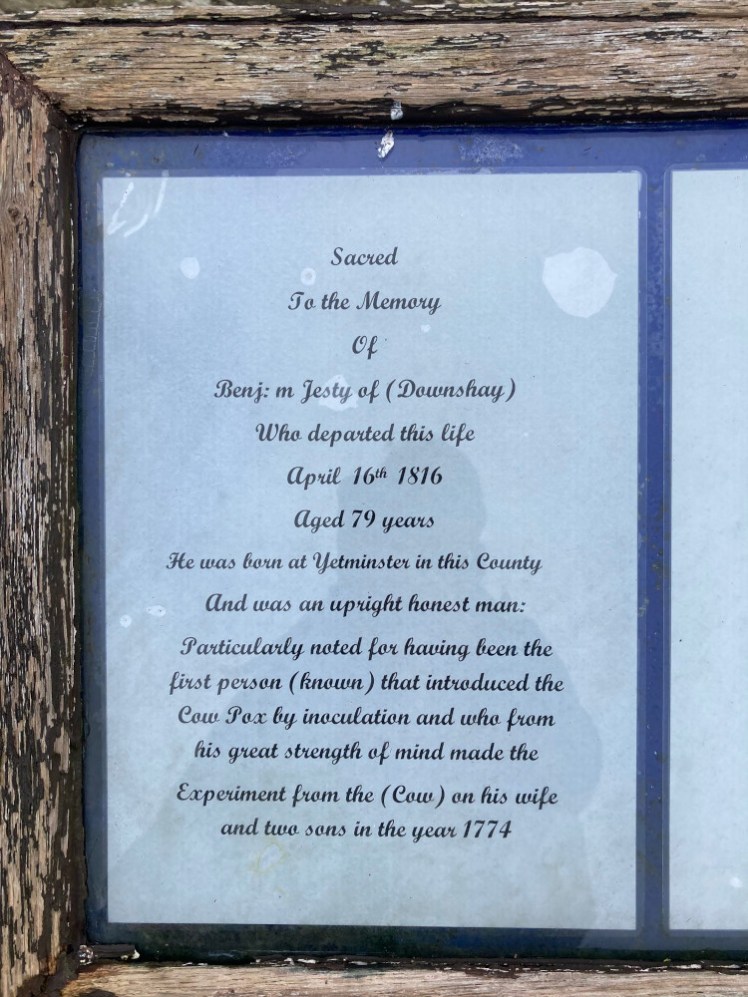
Now, go back round the duckpond and we’ll follow the path down to the sea. It’s a surprisingly long way, through cow fields and then onto a gravel path that leads past a house trying to hide from civilisation.
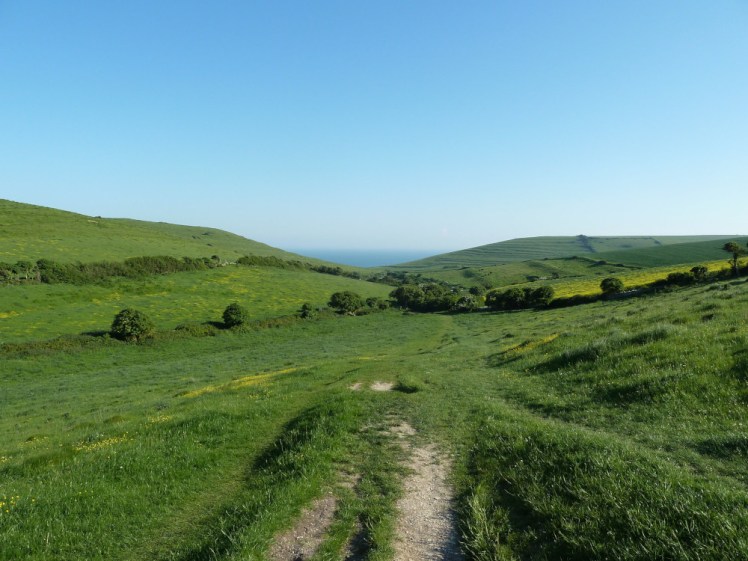
At the bottom, you’ll find the sea opens up before you. The path goes to the left but we’re going to take a few minutes to explore the Winspit Quarry on the right. Now, with my caving hat (helmet?) on, I’d tell you not to go in under any circumstances. These are eighteenth century quarries which predate any concept of health and safety. They’re open to the spray of the sea on violent days. They will collapse one day. That said, I have a habit of taking my headtorch and poking my head in. I mean, I can feel my own mortality staring me in the face as I do it but I’m drawn to the dark places beneath the Earth and so I always look.

Back outside, walk back up towards Worth for a couple of hundred metres until you spot a path leading across the cliffs on the other side of the little bay. The internet says it’s good for swimming but I’m accustomed to seeing these waves trying to beat the rocks to powder. Save your swimming for the end of this walk, ok?
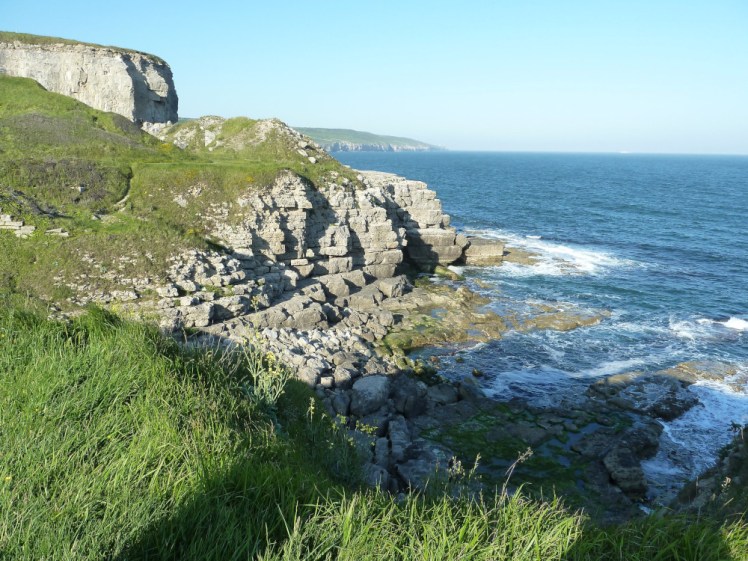
There’s a bit of a climb, via some steps, to the top of the cliff. Then you keep following the path until you get to Seacombe, which is a very obvious valley running down to the sea. It’s pleasant along here. Great sea views, great cliff views, mind the edge and mind the sinkholes – this is more chalk than limestone and there are great big hollows in the landscape here and there. They’re mostly fenced off, so understand that means you don’t get to explore and bear in mind that the ground here is a bit on the unstable side.

Seacombe is where we’re going to head back to Worth later on, so for now find your way down the side and back up the other side. Then keep going until you see a fenced off area with signs declaring it Dancing Ledge. This is… well, it’s a ledge. I assume it’s harder rock than the cliffs above it, which have all collapsed leaving a natural platform sticking out into the water. My experience of this place is that you have to scramble really awkwardly down the cliff side to get to the ledge. It’s popular with climbers and coasteering groups and, in this day and age, with Instagrammers. You see, Dancing Ledge is famous for its natural sea pool. I say natural. The sea pool cut and blasted out of the rocks. It fills naturally with sea water and although it’s mostly a reasonably safe place to swim in seawater, it is prone to big waves crashing over, so please use your sense. Of course you can swim here. But you can also pose for photos here!

If you’ve read the Malory Towers books, this is what Enid Blyton was thinking of when she described their pool, although I think the book version is about four times the size of the real one. It was built – built? – for Durnford School, a prep school up at Langton Matravers, one of these incredibly expensive schools for posh boys who are then treated horrendously. Ian Fleming, writer of James Bond, is a formal pupil. The school is no more, of course. Prep schools do still exist but the private ones in tiny villages are a thing of the past.
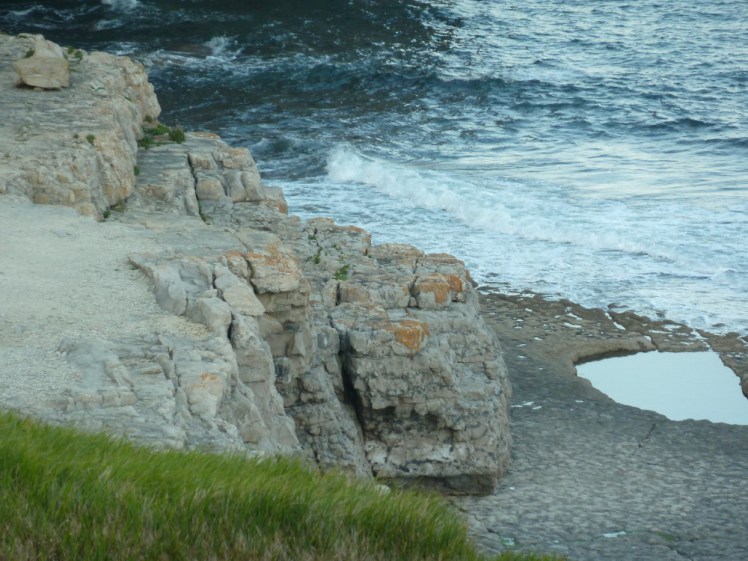
From here, you can follow the signs up to Spyway Barn and Langton Matravers but then you’ve got quite a long walk along single-track country lanes to get back to Worth Matravers, unless you’re lucky enough to happen on a bus – they’re not unknown around here but this isn’t London, there won’t be another one along in forty seconds. I’m going to take you back along the cliffs to Seacombe.

There are often cows grazing down here. I love cows and I like to softly, gently approach them with a hand out to see if they’re friendly. Very few are. I speak fluent cow, so I know when to back off. If you’re not a fan, they’re mostly not going to do much more than watch you suspiciously. Don’t get between an adult and a calf and you should be fine.

Walk up the valley. Eventually you’ll see a steep sharp track on your left, well-used, which I think leads to a gate. There might even be a signpost. Anyway, there are actually two short sharp climbs here and then you’ll be standing at the corner of a field overlooking hills rolling away down to the sea.
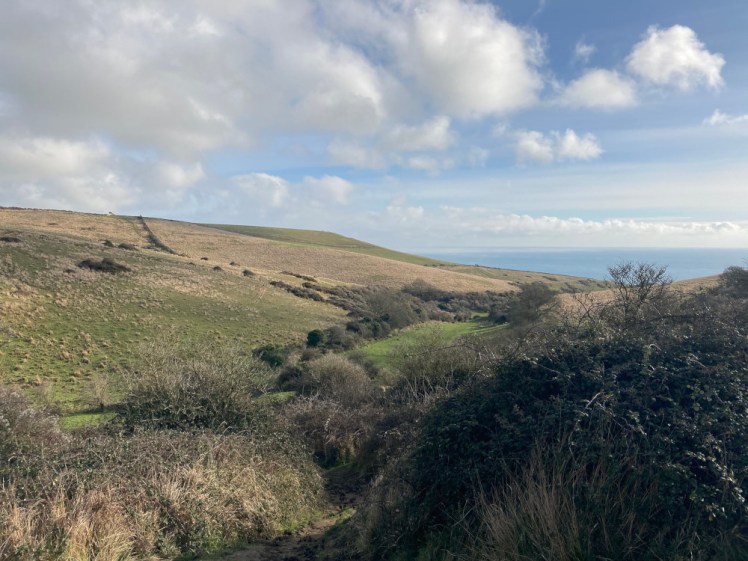
Keep the stone wall on your right and walk towards the stone wall in front of you. You’ll know you’re in the right place because this bearing should take you straight to a feature in the wall that allows you to climb over it. It’s not a stile, it’s a kind of smooth section of rock with some steps on each side.

Then follow the edge of the field back towards the village, emerging at a kissing gate onto the road. From here it’s a short walk back to the Square and Compass for a pint and a pasty you’ve absolutely earned, with sea views, possibly some chickens pecking around your feet and a quick visit to the pub’s fossil collection. This part of the Jurassic Coast is just made of fossils, although access to the cliffs to find them is somewhere between awkward and impossible, as you’ll have realised by now.

And that’s my favourite walk! It’s got scenery, it’s got caves, it’s got a pool, it’s got some hills and I now admit I haven’t walked it in nearly a year!